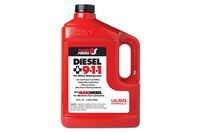People who live in cold climates know that home heating oil or Diesel, if exposed to very low temperatures (as in an outside, above-ground oil tank) can “wax out.” Waxing out is the process by which waxy components of these fuels can at low temperature form networks of interlocking solid crystals, capable of blocking filters. When I briefly inhabited a little house with an outside oil tank, I was advised to add five gallons of kerosene to each tank of oil to prevent waxing.
The same thing happened in early lubricating oils, making them so stiff that engines built before World War I (1914-18) were often equipped with cylinder petcocks through which a few drops of fuel could be added before starting (with a hand crank), to help break the bond between pistons and cylinders. The ability of an oil to remain fluid at low temperature was quantified as its “pour point.”
De-waxing at low temperatures helped, but because these waxy substances also had some positive properties, other means of lowering the pour point were sought. The result is pour-point depressant additives, which work by coating the faces of growing wax crystals, limiting their size and mutual adhesion. Such additives are effective in very small doses–a fraction of one percent.
Lube oils contain a veritable 'chemistry set' of additives which are there for a variety of purposes–to reduce wear, to maintain useful viscosity at high temperature, to disperse wear and sludge particles, allowing them to be carried to the filter, to prevent rust, to prevent oil from completely draining out of bearings during long shutdown. Most of the old-timers who scoffed at oil additives ("Sonny, give me an oil that's 100 percent oil!") are gone now. Their objections had some validity in 1950, when oil additives were in their infancy, but today oil additives have become essential to the high performance modern engines require from lubricants.
This is but one small example of the invisible technology that surrounds us in so many things we do.

/cloudfront-us-east-1.images.arcpublishing.com/octane/BNSDRE4DCJE5ZPOLGPBZPOMZEI.jpg)
/cloudfront-us-east-1.images.arcpublishing.com/octane/GO6FSVIIKNBVPLSIS7IBWE7AEM.jpg)
/cloudfront-us-east-1.images.arcpublishing.com/octane/CS6TMZNTENGKFDW56HSE2HFZ2M.jpg)
/cloudfront-us-east-1.images.arcpublishing.com/octane/FUFID44YDBAM3EHF2AV5LDHLVE.jpg)
/cloudfront-us-east-1.images.arcpublishing.com/octane/QKEXZXUGVFATPE7RAT3HAHDQZ4.jpg)
/cloudfront-us-east-1.images.arcpublishing.com/octane/T7GEMBOUDBHX7EDP2PRQ2J2XME.jpg)
/cloudfront-us-east-1.images.arcpublishing.com/octane/U4CKRUKLKZD43FDSDLZHBL7YVA.jpg)
/cloudfront-us-east-1.images.arcpublishing.com/octane/OFSXJJ5PZFEZ5D5ZPMCFVHJUMA.jpg)
/cloudfront-us-east-1.images.arcpublishing.com/octane/N2JLNLG44VEKBMEPORRDTMX5A4.jpg)
/cloudfront-us-east-1.images.arcpublishing.com/octane/PYWEGG6FHJD6XLPKICS7XHMMZ4.jpg)
/cloudfront-us-east-1.images.arcpublishing.com/octane/XXFQQQ4AYJDCXDGVW3JTHAYONI.jpg)
/cloudfront-us-east-1.images.arcpublishing.com/octane/WMF36OICPZEJDPKABMHQVHXBZ4.jpg)
/cloudfront-us-east-1.images.arcpublishing.com/octane/3DJ46QYFAJA5RIJILQR2XIZXM4.jpg)
/cloudfront-us-east-1.images.arcpublishing.com/octane/4HYMMY6K4JHMNEQ56FXTGAHKG4.jpg)
/cloudfront-us-east-1.images.arcpublishing.com/octane/KUENZXA3RFBIHIDGHEEVH6YNYE.jpg)
/cloudfront-us-east-1.images.arcpublishing.com/octane/UW6THULV65E4TDI4DWLOMDR7LY.jpg)
/cloudfront-us-east-1.images.arcpublishing.com/octane/5S5CDZTZPJBHJBLHENVXEFYKG4.jpg)

/cloudfront-us-east-1.images.arcpublishing.com/octane/RWF5RV5L55DMXMWZS2D3HZRJFA.jpg)
/cloudfront-us-east-1.images.arcpublishing.com/octane/JLDKEXSBAZGH7FAPRA5FMG4VII.jpg)
/cloudfront-us-east-1.images.arcpublishing.com/octane/GGOH2AQRSVHY5C5JLNEVYLB5SU.jpg)
/cloudfront-us-east-1.images.arcpublishing.com/octane/TJJEHV3ATZFFXHUYZABHXKE2DI.jpg)
/cloudfront-us-east-1.images.arcpublishing.com/octane/UH3JG2VVQFCWXKRD5AYN2XE3IE.jpg)
/cloudfront-us-east-1.images.arcpublishing.com/octane/SQNSZQE645HWFF6YIUPSHPXESQ.jpg)